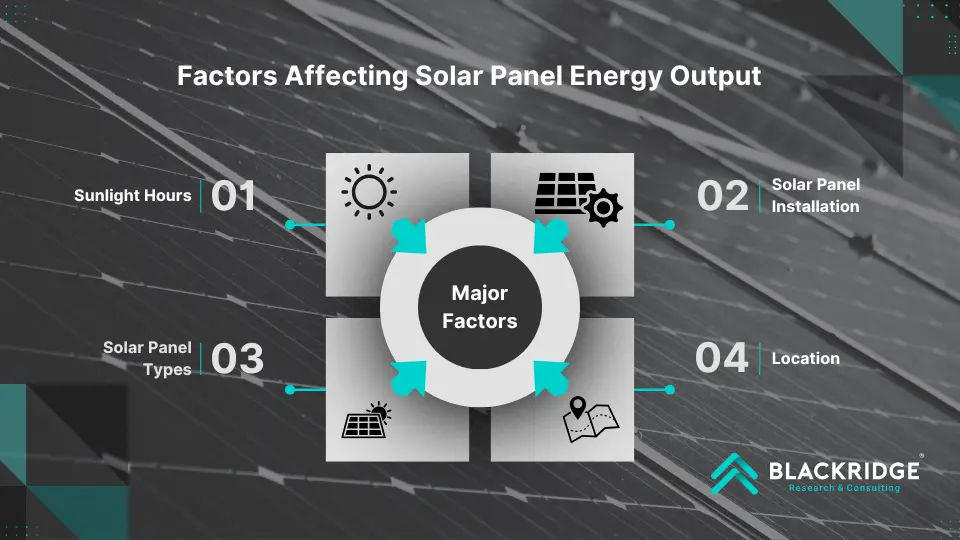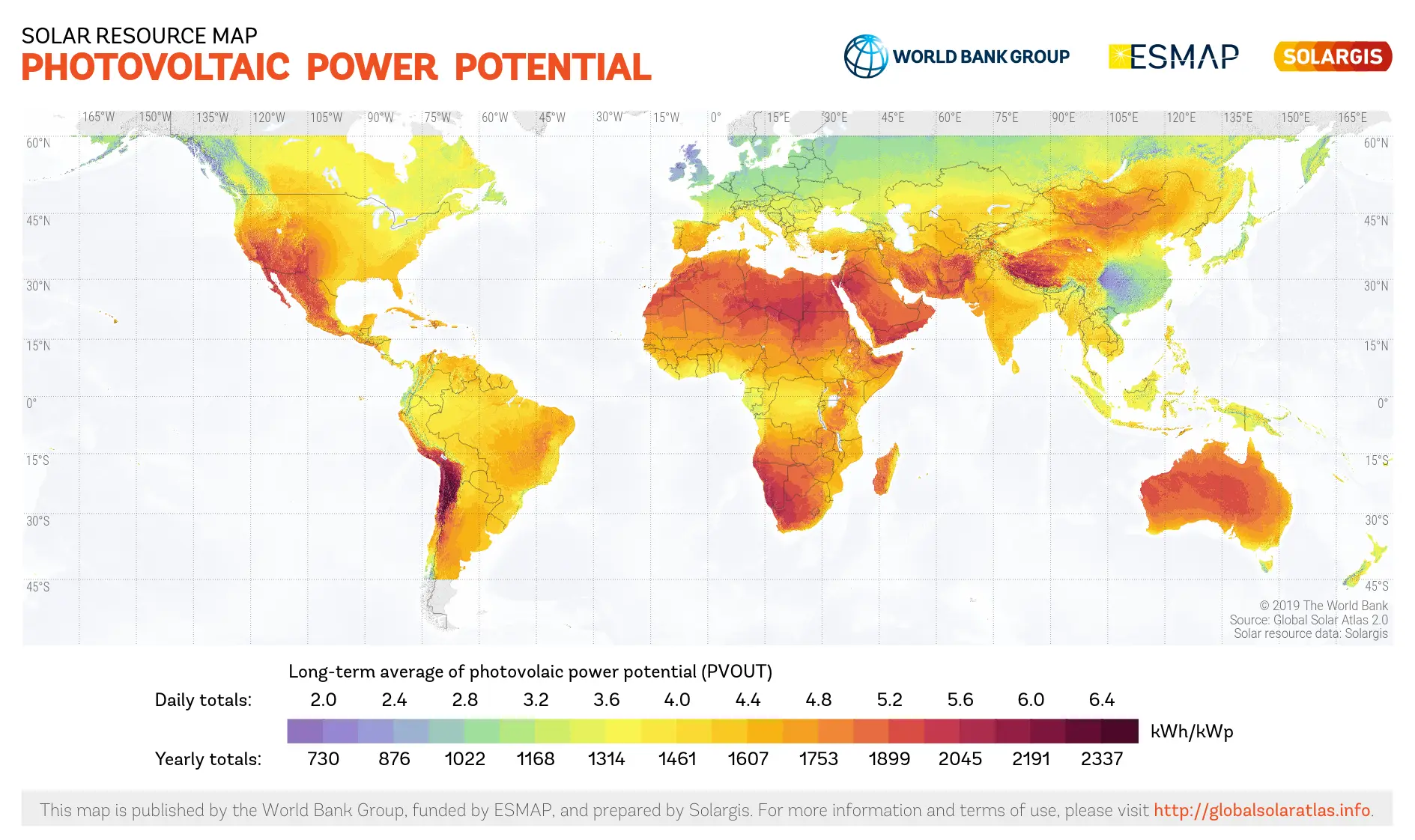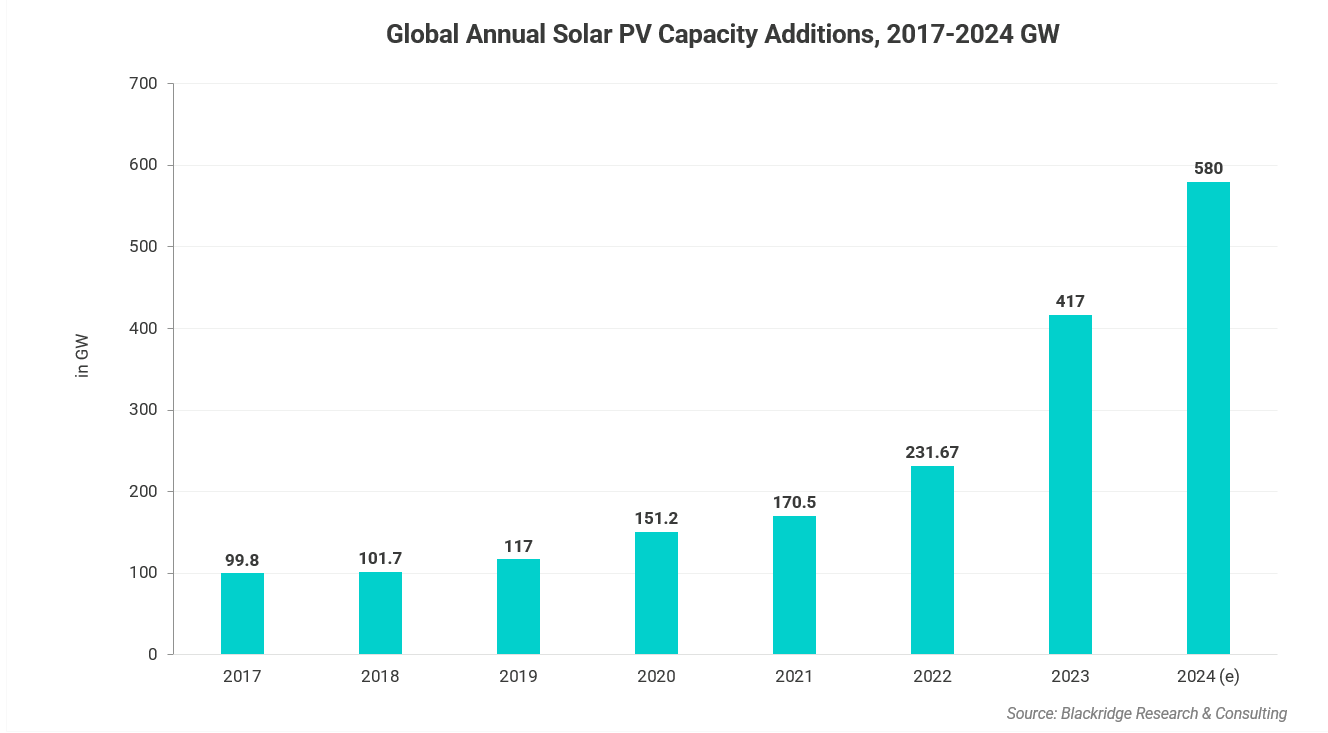Table of Contents
The energy produced by a solar panel are influenced by the solar panel's size, weather conditions, sunlight hours & intensity, solar panel type (monocrystalline or polycrystalline), and location.
Solar cells are packed together to form a solar module. Solar modules, when combined, create a solar PV (Photovoltaic) Panel. A solar PV panel can produce about 1 or 4 kWh (Kilowatt hours) daily. Solar PV Panels are combined in large-scale projects to form a solar array.
In this blog, we will cover how many kWh of energy solar panels produce, energy production based on panel sizes, leading countries in the solar power market, and much more; keep reading to learn more!
How Much Energy Do Solar Panels Generate?
A standard solar panel produces about 1- 4 kWh of solar energy daily. Under STC (Standard Test Conditions), a 1 kW solar panel produces 1 kWh of electricity in one hour. The total solar energy produced from a solar panel depends on the sunlight hours & its intensity.
The electricity produced from a solar panel is often calculated on a daily, monthly, and yearly basis. Furthermore, the project type, such as residential, commercial, or utility-based projects, also greatly influences the calculation!
How do I Calculate a Solar Panel’s Output?
For example, say a 400-watt solar panel receives 4 hours of sunlight in a day. To calculate the electricity in kWh produced from this watt panel, we calculate it as:
kW= 400W * 4 hours/1000= 1.6 kWh
Factors That Affect the Energy Produced From Solar Panel

Below are the factors that affect the production of solar energy from solar panels:
Total Sunlight Hours
Daily peak sunlight hours & its intensity directly impact the solar panel output energy. Often, solar energy produces peaks during midday and in summer when the sun is at its highest point.
Source: CAISO, Location: California
The solar duck curve is a graph that represents the electricity produced through solar power in megawatts throughout the day. The dip (solar belly) is formed when solar energy produced is maximum from 9:00 am to 3:30 pm, reducing the demand for energy from the grid. The duck neck in the graph is formed when the sunsets produce low solar energy, thus increasing the demand for energy from the grid.
Solar Installation
The installation of the solar panels directly affects the amount of solar light the solar panel receives. The orientation of the solar panels is as follows:
- Direction: Also known as the Azimuth angle, the solar panels face towards true south in the northern hemisphere and true north in the southern hemisphere to get maximum exposure to the sunlight.
- Inclination: The solar panel tilt must be equal to the latitude of the solar panel location for year-round solar energy production.
- Tracking Systems: The tracking system is divided into two:
Single-Axis Tracker: The solar panels rotate horizontally from east to west tracking the sunlight direction.
Dual-Axis Tracker: The solar panels can be titled and set at the Azimuth angle to track sunlight movement precisely.
- Shading: Any shade from trees or nearby objects must be avoided, which can reduce the solar panel's efficiency.
Panel Efficiency & Types
Monocrystalline and polycrystalline solar panels are the two most commonly used solar panels for converting solar energy to sunlight. Monocrystalline solar panels provide 16% to 24% efficiency, which is considered more efficient when compared to polycrystalline solar panels with 13% to 16% energy.
The reason defined is monocrystalline solar panels are made of a single continuous silicone structure. In contrast, polycrystalline panels are made of multiple silicone structures that break the free flow of electrons, reducing the overall solar panel efficiency.
Location

Source: Solargis
The location of the solar panel is one of the primary factors that affect the solar energy produced during sunlight hours. Often, the countries near the equator receive maximum sunlight, called solar irradiance. These countries are called sunshine countries, between the Tropic of Cancer and the Tropic of Capricorn. Countries like China, the United States, Germany, India, and Spain are among the top competing countries.
Also Read: Top 10 List of Solar PV Module Manufacturers in 2024
Solar Panel Wattage & Power Output
The energy produced by a solar panel depends on several factors; a traditional 1kW solar panel produces a minimum of about 4 units of solar energy per day. The solar energy produced based on a solar panel capacity is given below:
| Solar Panel Capacity | Units Produced per Day |
| 1 kW | 4-5 units |
| 2 kW | 8-10 units |
| 3 kW | 12-15 units |
| 4 kW | 16-20 units |
How do I store the electricity my panels generate?
The electricity produced from solar panels can be stored in batteries. The energy stored in the battery storage can be used in residential and commercial solar systems, and electric vehicles (EV).
Also Read: An Essential Guide to Battery Energy Storage System
Comparing Residential, Commercial, and Utility-Scale Solar Panel Energy Production
| Type | Power Output (per panel) |
| Residential | 250 - 400 watts |
| Commercial | 400 - 500 watts |
| Utility-Scale | 480 - 700 watts (approximate) |
Residential Solar Panels: The residential solar panel is often small in size and consists of not more than 60-72 cells with a standard energy output of 250-400 watts.
Commercial Solar Panels: Commercial solar panels produce about 400-500 watts of energy and are often installed as rooftop or ground-mounted solar projects.
Utility-based Solar Panels: Solar panels in a utiltiy-scale project produce approximately about 480 - 700 watts of solar energy per panel. Utility-scale solar projects are large-scale solar farm projects that produce thousands of watts per panel under STC conditions.
Solar panels are widely implemented across several sectors through residential, utility-based, and commercial projects. Recently, residential solar panel installations surged thanks to its cost-saving benefits.
How can you save on Solar Panel Installation?
Several governments are supporting solar panel implementation through grants and incentives.
The US government’s federal solar tax credit is a tax credit that can be claimed on federal income taxes for the cost of a solar PV system. According to this tax credit:
- Solar PV systems installed in 2020 & 2021 are eligible for a 26% tax credit.
- Solar PV installations between 2022-2032 are eligible for a 30% tax credit under the ITC (Investment Tax Credit) 2022.
Are you struggling to find the right incentives for your project? To ease your struggles, Blackridge Research & Consulting has partnered with IncentiFind to help you maximize your savings through incentives, tax credits and subsidies at both state-level and federal level.
Register using the link below to boost your project savings from over 500,000 incentives applicable for your project:
Global Solar PV Market
Global solar PV installations are expected to reach 580 GW by the end of 2024. In 2023, the global photovoltaic (PV) installed capacity witnessed remarkable growth, surging to a cumulative 1,412 GW (approximately 1.2 TW).
This growth was led by China, with a majority market share in 2023; it was alone responsible for 57% of the world’s total solar PV additions. The regional solar PV developments of 299 GW were observed in China in 2024. The growth of solar PV is anticipated in the years 2025-2028, and it is highly driven by factors such as cost improvements, product availability, and technology.
As a global-level initiative for clean energy, the International Solar Alliance (ISA), a global intergovernmental organization, was conceptualized at COP21 in Paris in 2015. This collaborative initiative between India and France has about 100 + countries as signatories and 90+ countries having ratified to become full members. It aims to achieve USD 1 trillion in solar investments by 2030.

Track the latest solar trends and insights with Blakcridge’s Global Solar PV Market Report.
Get Customized Global Solar PV Market Report Download a Sample Report!
A Quick Guide On Energy Produced From Solar Panel
How much power does 1 solar panel produce per day?
A solar panel can produce about 2 kWh of solar energy per day under optimal weather conditions.
How much energy does a solar panel produce per hour?
A residential solar panel can produce about 250 - 400 watts of solar energy per hour. Meanwhile, commercial solar panels can produce about 400-500 watts of solar power.
How much energy does a solar panel produce per year?
The energy produced from a solar panel annually is calculated in kWh. You can calculate the energy produced by multiplying solar panel watts with the number of peak sunlight hours.
How many units can a solar panel produce in optimal conditions?
Under ideal conditions, a 350-watt solar panel can produce 350 watts of solar power under peak sunlight hours. If the area receives 6 hours of peak sunlight, it can produce 350 watts* 6 hours of sunlight, giving 2100 watt-hours or 2.1 kWh units.
How many units does a 10kw solar system produce?
Under optimal sunlight conditions of 4-5 hours, a 10 kW solar system can produce about 40-50 kWh or 40-50 units.
How many kWh does a residential solar panel generate daily?
A residential solar panel can generate between 1 and 4 kilowatt-hours (kWh) of daily electricity. However, it can depend on location, size, and the sunlight hours.
How much power does a solar panel produce per square foot?
A solar panel produces 8-10 watts of power per square foot. This can vary depending on several factors, such as panel type, weather conditions, and efficiency.
Track Latest Solar PV Projects Across the Globe! Click to Know More
How many solar panels are needed to run a house?
The number of solar panels required primarily depends on the house's energy consumption, location, weather conditions, and size of the solar panel.
For example, if your house has about 800 kWh of energy per month, it is 26.67 kWh daily. You can calculate the number of solar panels as follows:
Solar Panel Output: Residential solar panels produce about 250-400 watts of solar energy. If your house location receives about 5 hours of sunlight, then,
Calculation: 250*5= 1250Wh or 1.25 kWh.
So to meet the per day demand of 26.67 kWh, we need = 26.67 kWh /1.25 kWh = 21.33 panels.
Is one solar panel enough to run a house?
No, a solar panel is not sufficient to run a house. The number of solar panels required is based on the house's energy consumption. According to the US Energy Information Administration, as of 2022, the average energy consumption of a household is 30 kWh per day.
How big is 1 kW solar panel?
A 1 kW solar panel is 65 inches to 39 inches in size. However, the size can vary based on the number of solar cells used and the project type (residential, commercial, and utility-based).
How many solar panels do I need for 500 kWh per month?
About 16.6 kWh of energy is consumed per day, to calculate the number of solar panels for a residential project, we need 3400 watts of solar capacity, equal to 13-14 residential solar panels.
Conclusion
The energy produced from a solar panel is based on size, panel type, location, and weather conditions. The energy produced from solar panels also depends on the project type, wherein utility-scale solar panel projects produce maximum solar energy, followed by commercial and residential solar panels.
Solar energy is widely used across several sectors and is considered a reliable energy source. Several country governments are promoting solar energy through residential, commercial, and utility-scale solar projects backed by incentives.
Track the Latest Global Solar PV Projects through a Unified Platform!
Blackridge’s Global Solar PV database covers projects from 150+ countries and is updated with real-time, accurate, and updated project developments. Unlock business opportunities through:
- Seamless Access Anywhere: Access projects in any chosen location
- Real-Time Data: Track upcoming projects, tenders, and contract awards
- Early-Stage Insights: Spot business opportunities before your competitors
- In-Depth Details: Project scope, capacity, funding, timelines, and key contacts
- Seamless Navigation: Explore projects across all development phases with ease
Expand your business horizons by booking a free demo today!
Disclaimer: This blog includes affiliate links, meaning we may earn a small commission if you buy through these links at no extra cost to you. Thank you for your support!

![Top 10 Solar EPC Companies in the World [2025]](https://images.blackridgeresearch.com/zA7C1E09-z4Uj64Eb0zfkw/7e940e76-1298-4e56-cb1c-114568b73100/public)





Leave a Comment
We love hearing from our readers and value your feedback. If you have any questions or comments about our content, feel free to leave a comment below.
We read every comment and do our best to respond to them all.